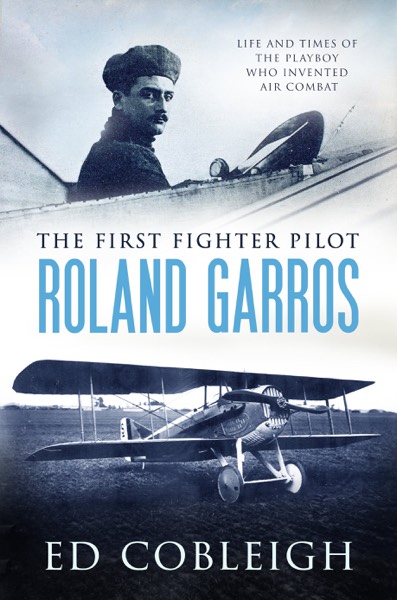
The world knows the name “Roland Garros” from the eponymous French national tennis center and tournament, but who was Roland Garros? A tennis professional? No, Roland Garros was the first fighter pilot. He abandoned a sybaritic Belle Epoque life, left a gorgeous lover, and volunteered to fly and fight in the lethal skies of World War I. Never before had a lone pilot hunted other men in the air. This creative biography traces the history of a pioneer aviator, first to conquer the Mediterranean, who was also a lawyer, a sports car salesman on Le Champs-Elysées, an air show pilot and racer, a world-class athlete, a pianist, and a prisoner of war. He escaped from the prison, made his way across Germany and the front lines back to Paris. After an affair of the heart with exotic dancer Isadore Duncan, he rejoined his squadron, needing two more victories to be anointed an ace. His is the untold story of a French-colonial boulevardier playboy who invented air combat and became the world’s first fighter pilot. In English.
Le monde connaît le nom «Roland Garros» du centre et tournoi de tennis français, mais qui était Roland Garros? Un professionnel de tennis? Non, Roland Garros a été le premier pilote de chasse. Il abandonna une vie sybarite Belle Epoque, a laissé une amoureuse magnifique, et se porta volontaire pour voler et combattre dans les cieux meurtriers de la Première Guerre Mondiale. Jamais auparavant un seul pilote n'avait chassé d'autres hommes dans les airs. Cette biographie créative retrace l'histoire d'un pionnier aviateur, premier conquérant de la Méditerranée, également avocat, vendeur de voitures de sport sur Le Champs-Élysées, pilote de spectacle aérien et pilote de course, athlète de classe mondiale, pianiste, et un prisonnier de guerre. Il s'est échappé de la prison, a traversé l'Allemagne et les lignes de front jusqu'à Paris. Après une liaison de cœur avec une danseuse exotique, Isadora Duncan, il rejoignit son escadrille, ayant besoin de deux autres victoires pour être sacré un « ace « . Il raconte l’histoire inédite d’un boulevardier colonial français qui a inventé le combat aérien et est devenu le premier pilote de chasse au monde. En le anglais.
Genre: BIOGRAPHY & AUTOBIOGRAPHY / HistoricalMy book is selling well in several countries but needs more exposure in France and should sell well there in French.
Five years after Roland Garros’ death, a small monument was dedicated to his honor on the Champs-Elysées in Paris, but this was not to be the most famous remembrance to his memory.
During the first decade of the 20th century, Garros played on the French national Rugby team with another athlete, Emile Lesieur. Lesieur also flew as a Pilote de Chasse or fighter pilot during the Great War. He survived and after the war took up a senior position in the French amateur athletic community. Lesieur remembered fondly his association with Garros on the Rugby field and as a fighter pilot. He understood the contribution Garros made to the world of tactical aviation. The older Frenchman felt Garros had not been given the recognition he deserved. French flying aces like Nungesser, Fonck, and Guynemer were national heroes celebrated throughout the land, while Garros remained a footnote. Roland Garros entered the history books as one of a few early aviation pioneers and as the first pilot to span the Mediterranean by air. However, according to Lesieur, the world’s first fighter pilot deserved more credit for showing the way for those who came after.
During the 1920s, France was a powerhouse in international tennis, winning the Davis Cup in 1927. To defend the cup, Lesieur was commissioned to build a new clay tennis court and stadium in an eastern suburb of Paris. He did so and demanded the facility be named after Roland Garros. The Roland Garros National Tennis Center is there today and is the site of what the world calls the “French Open” but is known in France as the “Le Tournoi de Roland-Garros” Over the decades the center has grown to occupy a square city block with multiple courts, grandstands, a gift shop, a restaurant (after all, this is France), and supporting buildings. The memorial has outgrown its subject.
| Language | Status |
|---|---|
|
Italian
|
Translation in progress.
Translated by chiara pennacchi
|
|
Portuguese
|
Already translated.
Translated by Luis Cabrita
|
|
Spanish
|
Already translated.
Translated by Roberto Peña Páez
|
|
|
Author review: The translation was done in short order and appears to be correct. Mr. Paez was easy to work with and very responsive. I would recommend him to anyone. |